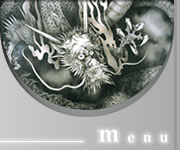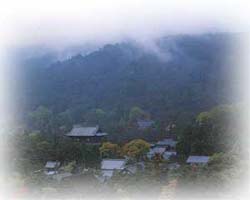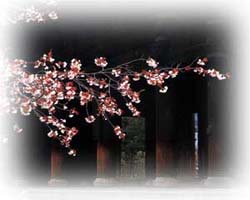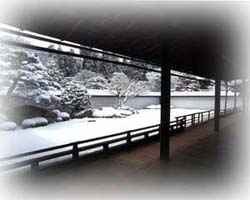

|
Top >
Head Temples -
Nanzen-ji Temple
Head TemplesTemple Name: Nanzen-ji 南禪寺Mountain Name: Zuiryusan 瑞龍山Address: Nanzen-ji Fukuchi-cho, Sakyo-ku, Kyoto-shi, 606-843 Japan http://www.nanzen.net/english/

Nanzen-ji, “Southern Zen Temple,” is the head temple of the Nanzen-ji school of Rinzai Zen Buddhism. It is part of the Gozan 五山 (Five Mountains) system of Kyoto Zen temples, but stands in a special position, being placed above the five temples of the Five Mountains proper (Tenryu-ji, Shokoku-ji, Kennin-ji, Tofuku-ji, and Manju-ji). Nanzen-ji had its beginnings in 1264 as a villa built by Emperor Kameyama (r. 1260–1274) at the foot of Higashiyama on the eastern side of Kyoto. Soon after the emperor took up residence there, ghosts are said to have appeared. The priests of other schools were unable to exorcise the spirits, but silent meditation by the Zen monk Mukan Fumon 無關普門 (1212–1291) and his disciples restored the palace to peace. The emperor became Mukan’s student and designated his residence to become a Zen temple following his death (with the stipulation that the abbot always be “the greatest Zen monk in the land,” without regard to Dharma lineage).
|

 Most of Nanzen-ji’s
buildings were destroyed during the Onin War (1467–77), and consequently
most of the present structures date from the seventeenth century or later.
The abbots of the temple were closely affiliated with the shogunate during
the Tokugawa era (1603–1868), and are said to have helped keep watch over
the activities of the emperor. It is suggested that the huge Mountain Gate,
built in 1628 and with an excellent view of the entire city (including the
imperial palace), served as a type of observation post.
Most of Nanzen-ji’s
buildings were destroyed during the Onin War (1467–77), and consequently
most of the present structures date from the seventeenth century or later.
The abbots of the temple were closely affiliated with the shogunate during
the Tokugawa era (1603–1868), and are said to have helped keep watch over
the activities of the emperor. It is suggested that the huge Mountain Gate,
built in 1628 and with an excellent view of the entire city (including the
imperial palace), served as a type of observation post. Nanzen-ji’s main attraction are the rock gardens and fusuma paintings in the
Seiryo-den, originally an imperial palace building that was donated to the
temple in 1611, and that now serves as the abbot’s quarters. Another section
of the abbot’s quarters was originally part of the Fushimi Castle, built by
the warlord and national unifier Toyotomi Hideyoshi 豐臣秀吉 (1536-1598). Nanzen-ji also has a number of notable subtemples, among which Nanzen-in
南禪院, Tenju-an 天授庵, and Konchi-in 金地院 have especially fine Zen gardens.
Nanzen-ji’s main attraction are the rock gardens and fusuma paintings in the
Seiryo-den, originally an imperial palace building that was donated to the
temple in 1611, and that now serves as the abbot’s quarters. Another section
of the abbot’s quarters was originally part of the Fushimi Castle, built by
the warlord and national unifier Toyotomi Hideyoshi 豐臣秀吉 (1536-1598). Nanzen-ji also has a number of notable subtemples, among which Nanzen-in
南禪院, Tenju-an 天授庵, and Konchi-in 金地院 have especially fine Zen gardens.